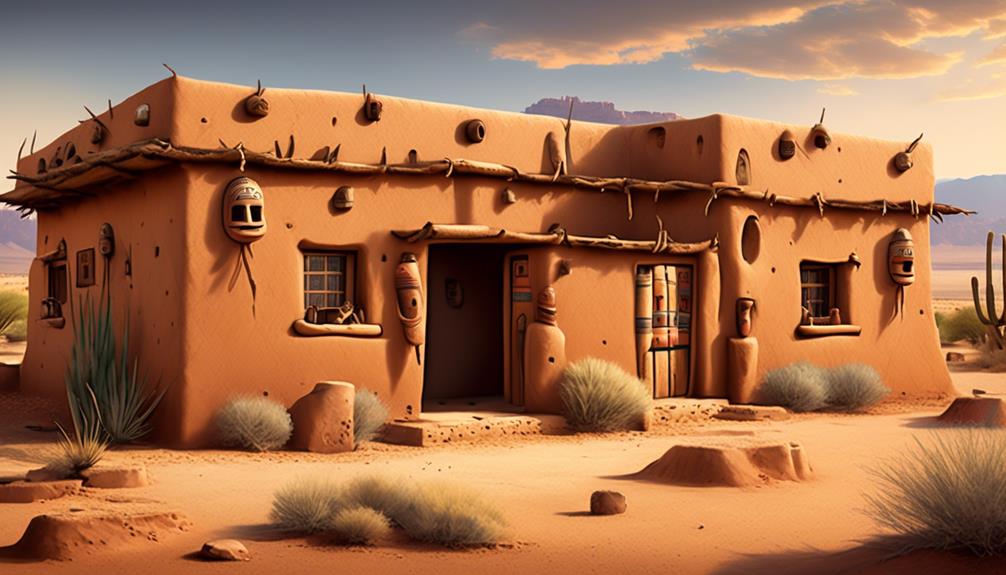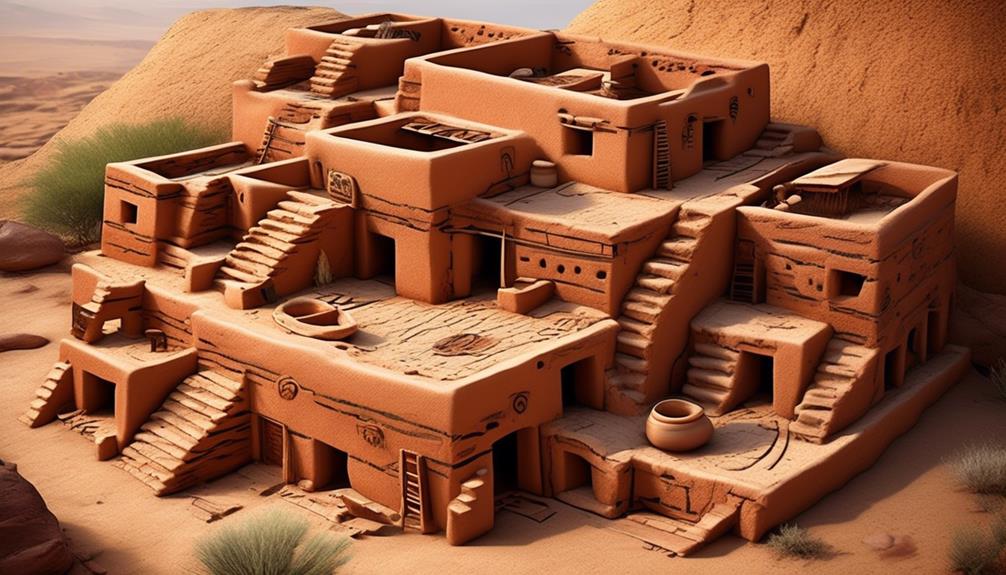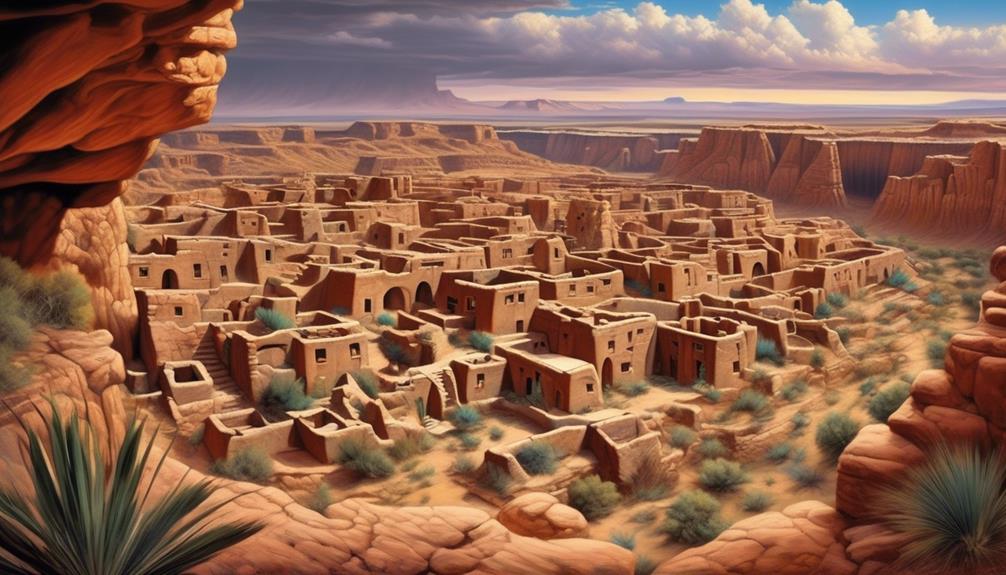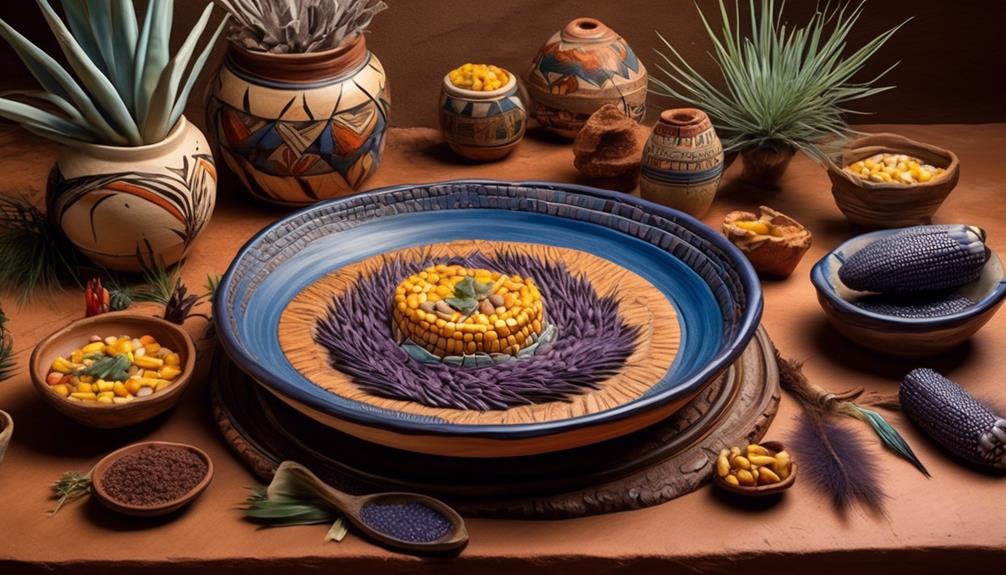The classic adobe dwellings of the Hopi tribe speak volumes about ancient times with their sun-bleached walls and natural colors. These houses, steeped in history and constructed by multiple generations, safeguard the mysteries of a community deeply rooted in the land, much like the sturdy foundations on which they stand.
But what was it about these adobe houses that made them more than mere shelters? And how did they come to reflect the profound cultural and spiritual beliefs of the Hopi tribe?
The answers lie within the very essence of these ancient structures, offering a glimpse into a world where architecture was not just a practical necessity, but a sacred art form.
Key Takeaways
- Hopi Adobe Houses date back hundreds of years and reflect enduring architectural traditions of the Hopi people.
- The construction of Hopi Adobe Houses involved a meticulous process, utilizing locally sourced materials such as clay, sand, and water.
- Hopi Adobe Houses are significant and symbolic, representing timeless traditions, cultural heritage, and spiritual beliefs of the Hopi community.
- Preservation of Hopi Adobe Houses is a challenge due to weather conditions and erosion, but they continue to serve as gathering places for cultural and spiritual activities, attracting visitors and contributing to cultural and economic vitality.
History of Hopi Adobe Houses
The history of Hopi adobe houses dates back hundreds of years, reflecting the enduring architectural traditions of the Hopi people. These traditional techniques have been passed down through generations, shaping the architectural evolution of the Hopi adobe houses.
The construction of these homes involved a meticulous process that utilized locally sourced materials such as clay, sand, and water, mixed together to form adobe bricks. These bricks were then sun-dried and stacked to create the walls of the houses. The use of traditional techniques ensured that the adobe houses were well-suited to the desert climate, providing excellent insulation against the extreme temperatures.
Over time, the architectural evolution of Hopi adobe houses saw the incorporation of additional features such as multiple stories, rooftop access, and communal courtyards. These changes were influenced by both practical considerations and cultural traditions, reflecting the deep connection between the Hopi people and their environment.
The unique blend of tradition and adaptation in the construction of Hopi adobe houses continues to be a testament to the ingenuity and resourcefulness of the Hopi people.
Construction Techniques and Materials
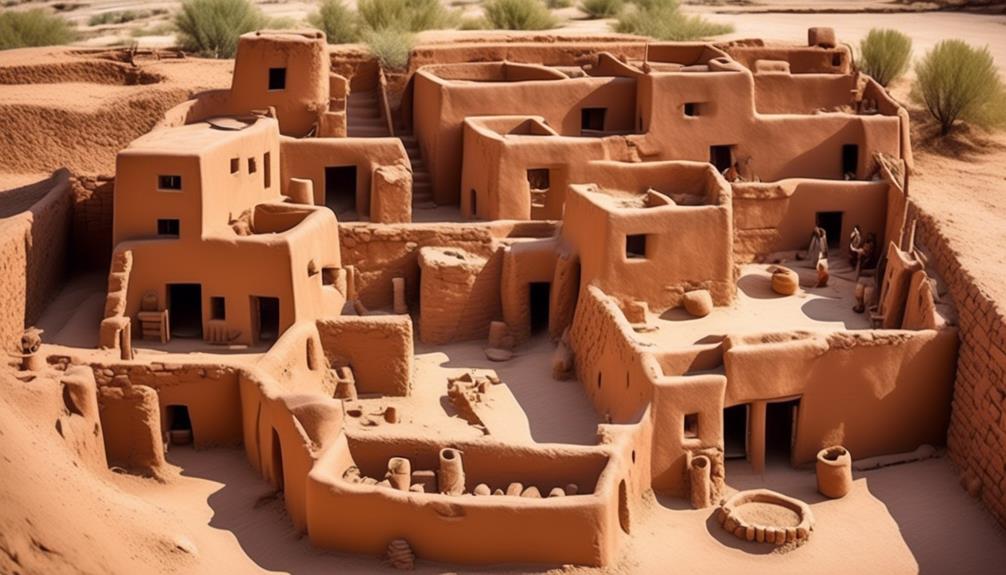
Utilizing locally sourced clay, sand, and water, we carefully mix these materials to form adobe bricks for the construction of Hopi adobe houses. Traditional techniques are employed to ensure the durability and sustainability of the structures. Here are the methods and materials used in constructing these remarkable adobe houses:
- Adobe Brick Formation
We mold the adobe bricks by hand, using wooden molds to create uniform shapes. This traditional method ensures the structural integrity of the bricks and allows for precise construction.
- Plastering Techniques
The walls of the adobe houses are plastered with a mixture of clay, sand, and straw. This technique not only provides a smooth and aesthetically pleasing finish but also reinforces the walls, adding to the overall strength of the structure.
- Roofing Materials
For the roofs, we use timber beams covered with a layer of packed earth. This sustainable roofing material provides insulation and effectively regulates the interior temperature of the adobe houses.
Significance of Hopi Adobe Houses
Constructed with deep respect for our cultural heritage, Hopi adobe houses represent the timeless traditions and values of our community. The significance of these structures lies in their embodiment of our cultural heritage and the preservation of our architectural design. The adobe houses aren't just physical dwellings; they're a reflection of our connection to the land, our ancestors, and our way of life.
The cultural heritage embedded in the adobe houses is a testament to the knowledge and skills passed down through generations. The architectural design of these houses isn't only functional but also holds symbolic meanings, often representing elements of our spiritual beliefs and social organization. The construction and maintenance of these homes serve as a unifying force for the community, fostering a sense of shared identity and purpose.
Furthermore, the adobe houses underscore our commitment to sustainability and harmony with nature. The use of locally-sourced materials and the integration of natural elements in the design reflect our reverence for the environment.
Thus, Hopi adobe houses stand as a living expression of our cultural heritage and a testament to the enduring values that define our community.
Cultural and Spiritual Meanings
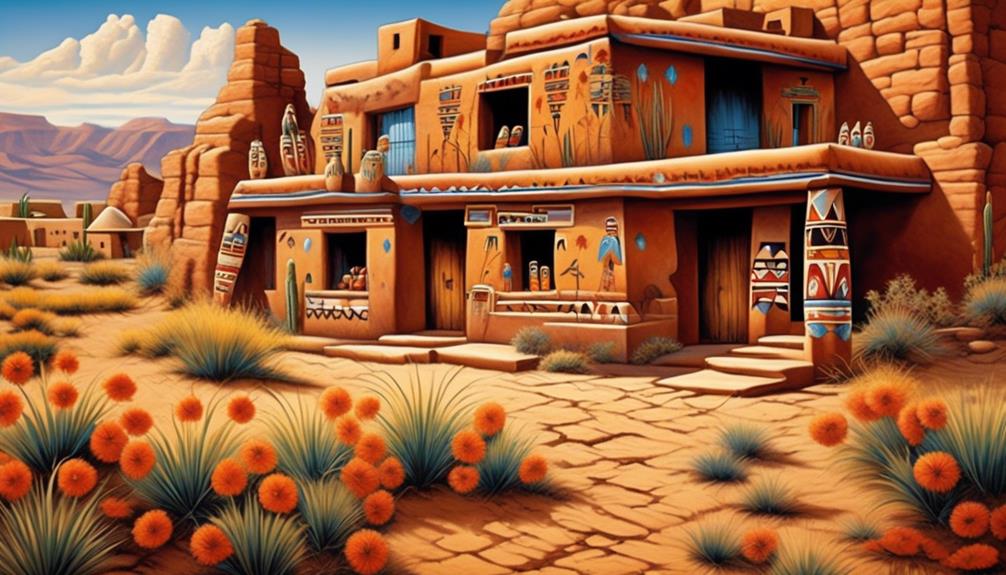
Embedded in the construction and maintenance of our adobe houses are cultural and spiritual meanings that reflect our deep connection to the land and our enduring values as a community.
- Spiritual Symbolism
The process of gathering and preparing the earth for adobe bricks is a sacred ritual, symbolizing our harmonious relationship with the natural elements. The act of shaping the adobe bricks by hand represents the spiritual connection between the builders and the earth, honoring the traditional belief in the interconnectedness of all living things.
- Traditional Architecture
The design and layout of our adobe houses are deeply rooted in our cultural heritage and spiritual beliefs. The circular shape of the adobe houses represents the cycle of life and the interconnectedness of our community. The orientation of the houses is aligned with the cardinal directions, emphasizing our reverence for the natural world and the spiritual significance of the sun's path.
- Community Values
The collaborative effort involved in constructing adobe houses fosters a sense of unity and cooperation within our community. The shared knowledge and skills passed down through generations reinforce our cultural identity and spiritual connection to our ancestors.
Preservation and Impact Today
Preserving our adobe houses is essential for maintaining our cultural heritage and ensuring their continued impact on our community today. However, we face significant preservation challenges in keeping these traditional structures intact.
Harsh weather conditions, erosion, and the passage of time all pose threats to the adobe houses. Efforts to preserve them involve ongoing maintenance, repairs, and the use of traditional building methods and materials. Modern adaptations, such as protective coatings and reinforcement techniques, are also being explored to ensure the longevity of these structures.
Despite the challenges, the impact of our adobe houses on our community today remains undeniable. These buildings continue to serve as gathering places for cultural and spiritual activities, preserving our traditions and way of life. Additionally, they attract visitors from around the world, contributing to our community's cultural and economic vitality.
Frequently Asked Questions
How Did the Hopi Tribe Adapt Their Adobe Houses to Different Climatic Conditions Throughout the Year?
We adapted our adobe houses to different climatic conditions throughout the year using various techniques.
Seasonal modifications included adjustments to the thickness of the adobe walls to provide insulation, as well as the orientation of the houses to maximize sunlight during the winter and shade during the summer.
Additionally, we utilized natural ventilation and shading techniques to regulate the temperature inside the adobe houses, ensuring comfort and sustainability.
What Specific Rituals or Ceremonies Are Associated With the Construction of Hopi Adobe Houses?
Construction rituals associated with Hopi adobe houses hold immense cultural significance. These rituals involve communal efforts, symbolizing unity and respect for tradition. The process often includes prayers, blessings, and the participation of community members, reinforcing the tribe's spiritual connection to the land.
The ceremonies also emphasize the importance of sustainability and harmony with nature, reflecting the Hopi's deep-rooted cultural values. Such rituals ensure that each adobe house is a testament to the tribe's enduring traditions and spiritual beliefs.
Are There Any Traditional Techniques or Materials Used in the Construction of Hopi Adobe Houses That Have Been Lost or Replaced Over Time?
Over time, traditional techniques and building materials for Hopi adobe houses have seen changes due to climate adaptation and modern influences. We've lost some of the original methods and materials, but the cultural significance remains strong.
It's like losing pieces of a cherished family heirloom, yet the memories and stories attached endure. Despite the changes, the spirit of our ancestors lives on in the enduring walls of our adobe houses.
How Do Hopi Adobe Houses Differ From Other Native American Tribes' Traditional Dwellings?
Hopi adobe houses are unique among Native American dwellings due to their architectural features and cultural significance. These homes are constructed using traditional techniques and materials, such as clay and straw.
The construction techniques involve a communal effort, reflecting the tribe's strong sense of community and cultural identity.
The design and layout of Hopi adobe houses also differ from those of other tribes, showcasing the tribe's distinctive architectural style and connection to their environment.
What Are Some Common Misconceptions About Hopi Adobe Houses and Their Cultural Significance?
Common misconceptions about Hopi adobe houses often overlook their cultural significance. Many believe they were solely for shelter, but they were also a result of climate adaptation and construction rituals.
These dwellings weren't just about practicality, but also held deep spiritual and communal meaning. Understanding the cultural significance of these houses helps to appreciate the rich traditions and values of the Hopi tribe.
Conclusion
In conclusion, the Hopi adobe houses aren't just structures, but a symbol of resilience and tradition. Like the sturdy adobe bricks, the Hopi people have withstood the test of time, preserving their culture and heritage.
Just as each brick is essential to the strength of the house, each member of the Hopi tribe plays a vital role in upholding their traditions.
The adobe houses serve as a reminder of the enduring spirit and unity of the Hopi people.
